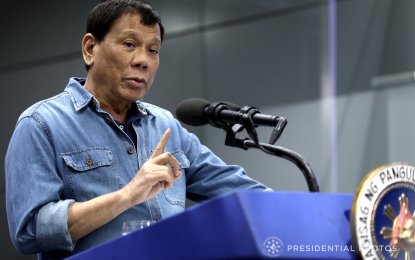Business and Economy
Duterte gov’t tops GDP allocation for infra

FILE: The Philippine government under President Rodrigo Duterte has allocated a bigger portion of its Gross Domestic Product (GDP) for infrastructure spending, compared with the average of the past six administrations in the last 50 years. (PNA PHOTO)
MANILA — The Philippine government under President Rodrigo Duterte has allocated a bigger portion of its Gross Domestic Product (GDP) for infrastructure spending, compared with the average of the past six administrations in the last 50 years.
“We are pouring in 5.4 percent in comparison to just 2.6 percent of the average of the past six administrations in the last 50 years,” said Build, Build, Build team chairperson Anna Mae You Lamentillo during the National Information Convention (NIC) in Davao City on Monday.
Lamentillo said the administration would spend PHP8.4 trillion in infrastructure in its six-year term, and this would be financed 80 percent by local borrowings.
In his 10-point socioeconomic agenda, Duterte aims to reduce Philippine poverty from 21.6 percent in 2015 to 13-15 percent by 2022.
Lamentilla said financing the speedy establishment of infrastructure and development of industries that would ease up the people’s lives and boost economic growth is one of the big changes the government is making.
Among the life-changing infrastructure projects the administration hopes to make real is the Metro Manila Skyway Stage 3, which is aimed at decongesting EDSA traffic, especially on rush hours.
The Build, Build, Build Portal lists down high impact projects envisioned to raise the economy’s productive capacity by creating jobs, increasing incomes, and strengthen the investment climate leading to sustained inclusive growth.
“It is a real-time tool where projects are monitored and tracked, with relevant information made available to everyone,” Lamentillo said of the Build, Build, Build portal, where private contractors could see government projects they might be interested in joining.
Other infrastructure projects underway are the Tarlac-Pangasinan-La Union Expressway Project, which will decongest the McArthur Highway; the Central Luzon Link Expressway Phase 1, which will connect Tarlac to Cabanatuan; the Central Luzon Link Expressway Phase 2, which will connect San Jose to Nueva Ecjia; the Plaridel Bypass Road Project Phase 1, which will accommodate travelers heading to Balagtas, Guiguinto, Plaridel, Bustos, and San Rafael, Bulacan; the North Luzon East Expressway, which will allow a scenic view of North East Luzon;
The North Luzon Expressway (NLEX) Harbor Link Segment 10, which will allow for faster travel through Radial Road 10, Mindanao Ave., and Commonwealth Ave.; the NLEX and South Luzon Expressway (SLEX) link, which will reduce travel time from Clark to Calamba; the Ninoy Aquino International Airport (NAIA) Expressway Phase 2, which will provide access to NAIA Terminal 1, 2 and 3 including Skyway and Cavitex; the
Runway Manila, which will allow easy access to Manila’s top hotels; the Southeast Metro Manila C6 Phase, which will connect Skyway Stage 1 at FTI to C5 towards Laguna de Bay; the Cavite-Laguna Expressway, which will connect CAVITEX and the South Luzon Expressway (SLEX) Mamplasan Interchange;
The Quezon-Bicol Expressway, which allows safer travel instead of using winding roads; Camarines Sur Expressway, which will serve as an alternative route to Naga City and Pili; and the SLEX Toll Road 4, which will allow easy access to Laguna, Batangas, Quezon, and the Bicol Region.
Department of Budget and Management Secretary Benjamin Diokno earlier said infrastructure spending would rise from 5.3 percent of GDP in 2017 to 7.4 percent of GDP in 2022.
Department of Labor and Employment Secretary Silvestre Bello III also said earlier the Build, Build, Build program would generate more than 12 million jobs over the next five years.
Bello pointed out most of the new jobs will be in the field of manufacturing and construction, including carpenters, welders, plumbers, and electricians.
The Build, Build, Build campaign also includes projects, such as the Mega Manila Subway, Mindanao Railway, and the Bases Conversion and Development Authority Smart City Solutions.
The program targets to address challenges in employment, traffic, and inflation.
The projects are targeted to be completed from 2017-2022.





















